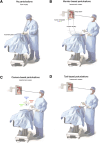Sensorimotor Challenges in Minimally Invasive Surgery: A Theoretically-Oriented Review
- PMID: 39038166
- PMCID: PMC11626857
- DOI: 10.1177/00187208241263684
Sensorimotor Challenges in Minimally Invasive Surgery: A Theoretically-Oriented Review
Abstract
Objective: This review surveys the literature on sensorimotor challenges impacting performance in laparoscopic minimally invasive surgery (MIS).
Background: Despite its well-known benefits for patients, achieving proficiency in MIS can be challenging for surgeons due to many factors including altered visual perspectives and fulcrum effects in instrument handling. Research on these and other sensorimotor challenges has been hindered by imprecise terminology and the lack of a unified theoretical framework to guide research questions in the field.
Method: We conducted a systematic survey of the MIS literature, focusing on studies investigating sensorimotor challenges affecting laparoscopic performance. To provide a common foundation for cross-study comparisons, we propose a standardized taxonomy that distinguishes between different experimental paradigms used in the literature. We then show how the computational motor learning perspective provides a unifying theoretical framework for the field that can facilitate progress and motivate future research along clearer, hypothesis-driven lines.
Results: The survey identified diverse sensorimotor perturbations in MIS, which can be effectively categorized according to our proposed taxonomy. Studies investigating monitor-, camera-, and tool-based perturbations were systematically analyzed, elucidating their impact on surgical performance. We also show how the computational motor learning perspective provides deeper insights and potential strategies to mitigate challenges.
Conclusion: Sensorimotor challenges significantly impact MIS, necessitating a systematic, empirically informed approach. Our proposed taxonomy and theoretical framework shed light on the complexities involved, paving the way for more structured research and targeted training approaches to enhance surgical proficiency.
Application: Understanding the sensorimotor challenges inherent to MIS can guide the design of improved training curricula and inform the configuration of setups in the operating room to enhance surgeon performance and ultimately patient outcomes. This review offers key insights for surgeons, educators, and researchers in surgical performance and technology development.
Keywords: medical simulation/training and assessment; motor control; motor learning; performance; sensorimotor-adaptation; simulation and training; skilled; surgical training.
Conflict of interest statement
Declaration of Conflicting InterestsThe author(s) declared no potential conflicts of interest with respect to the research, authorship, and/or publication of this article.
Figures



Similar articles
-
Training curriculum in minimally invasive emergency digestive surgery: 2022 WSES position paper.World J Emerg Surg. 2023 Jan 27;18(1):11. doi: 10.1186/s13017-023-00476-w. World J Emerg Surg. 2023. PMID: 36707879 Free PMC article. Review.
-
Use of a Low-Cost Portable 3D Virtual Reality Gesture-Mediated Simulator for Training and Learning Basic Psychomotor Skills in Minimally Invasive Surgery: Development and Content Validity Study.J Med Internet Res. 2020 Jul 14;22(7):e17491. doi: 10.2196/17491. J Med Internet Res. 2020. PMID: 32673217 Free PMC article.
-
The Effect of Formal Robotic Residency Training on the Adoption of Minimally Invasive Surgery by Young Colorectal Surgeons.J Surg Educ. 2018 May-Jun;75(3):767-778. doi: 10.1016/j.jsurg.2017.09.006. Epub 2017 Oct 18. J Surg Educ. 2018. PMID: 29054345
-
Satisfaction of surgeons with the current state of training in minimally invasive surgery: a survey among German surgeons.Surg Endosc. 2024 Feb;38(2):1029-1044. doi: 10.1007/s00464-023-10584-y. Epub 2023 Dec 12. Surg Endosc. 2024. PMID: 38087109 Free PMC article.
-
Rasmussen's model of human behavior in laparoscopy training.Surg Endosc. 2003 Aug;17(8):1241-6. doi: 10.1007/s00464-002-9140-z. Epub 2003 Jun 13. Surg Endosc. 2003. PMID: 12799883 Review.
Cited by
-
Percutaneous endoscopy in the management of intra-abdominal complex disorders.BMC Gastroenterol. 2025 Aug 5;25(1):556. doi: 10.1186/s12876-025-04155-9. BMC Gastroenterol. 2025. PMID: 40764524 Free PMC article.
References
-
- Akamatsu M., MacKenzie I. S. (2002). Changes in applied force to a touchpad during pointing tasks. International Journal of Industrial Ergonomics, 29(3), 171–182. 10.1016/s0169-8141(01)00063-4 - DOI
-
- Almeida L., Menezes P., Dias J. (2020). Interface transparency issues in teleoperation. Applied Sciences, 10(18), 6232. 10.3390/app10186232 - DOI
Publication types
MeSH terms
LinkOut - more resources
Full Text Sources

